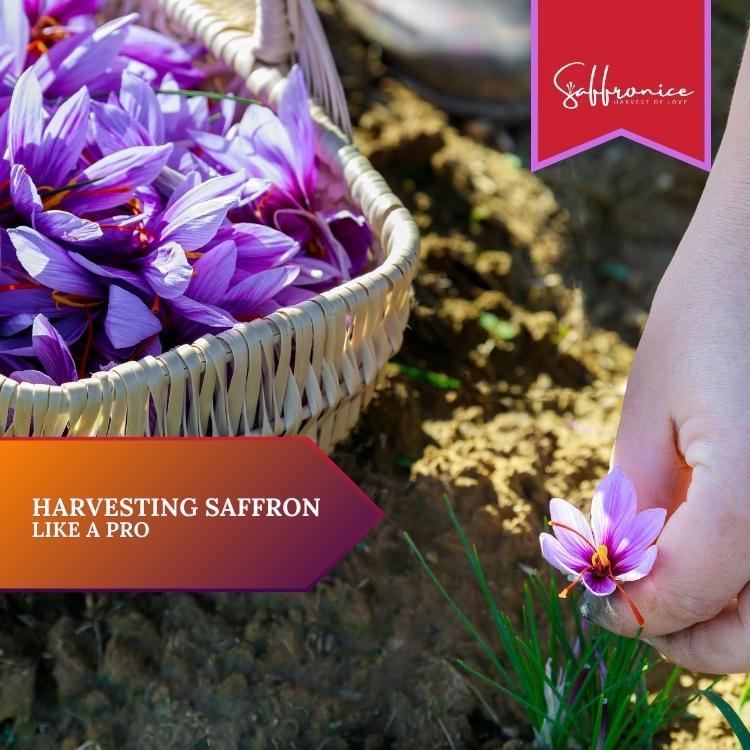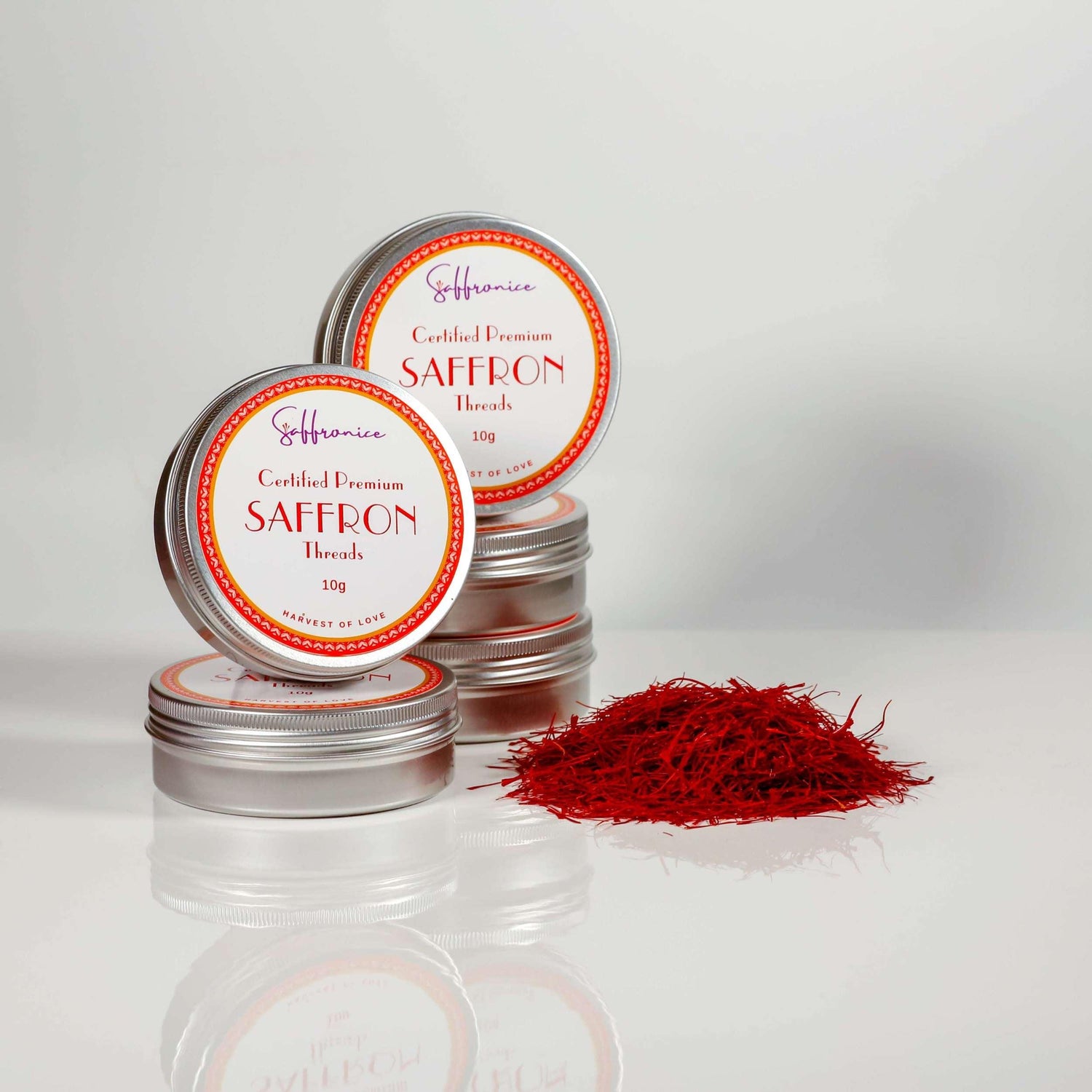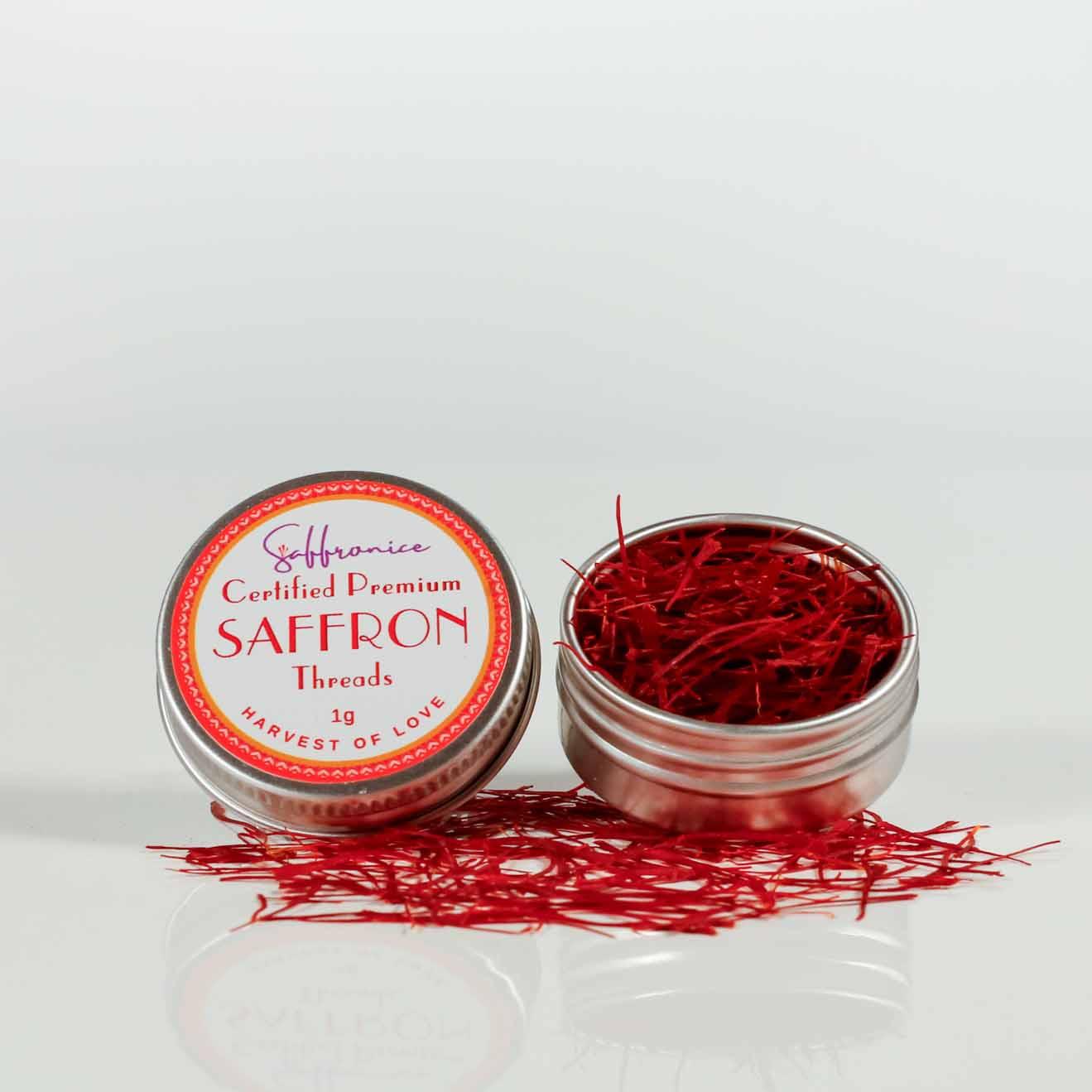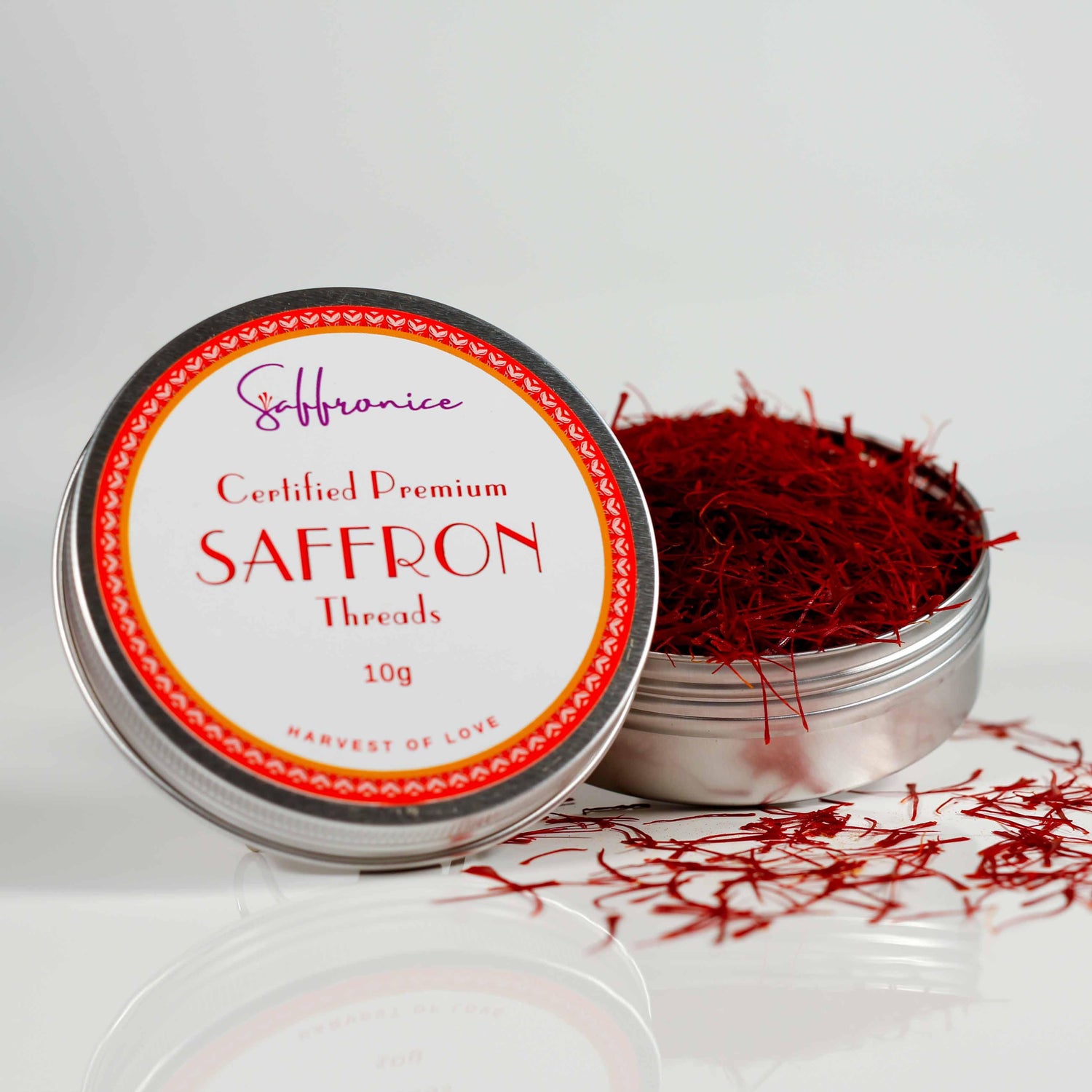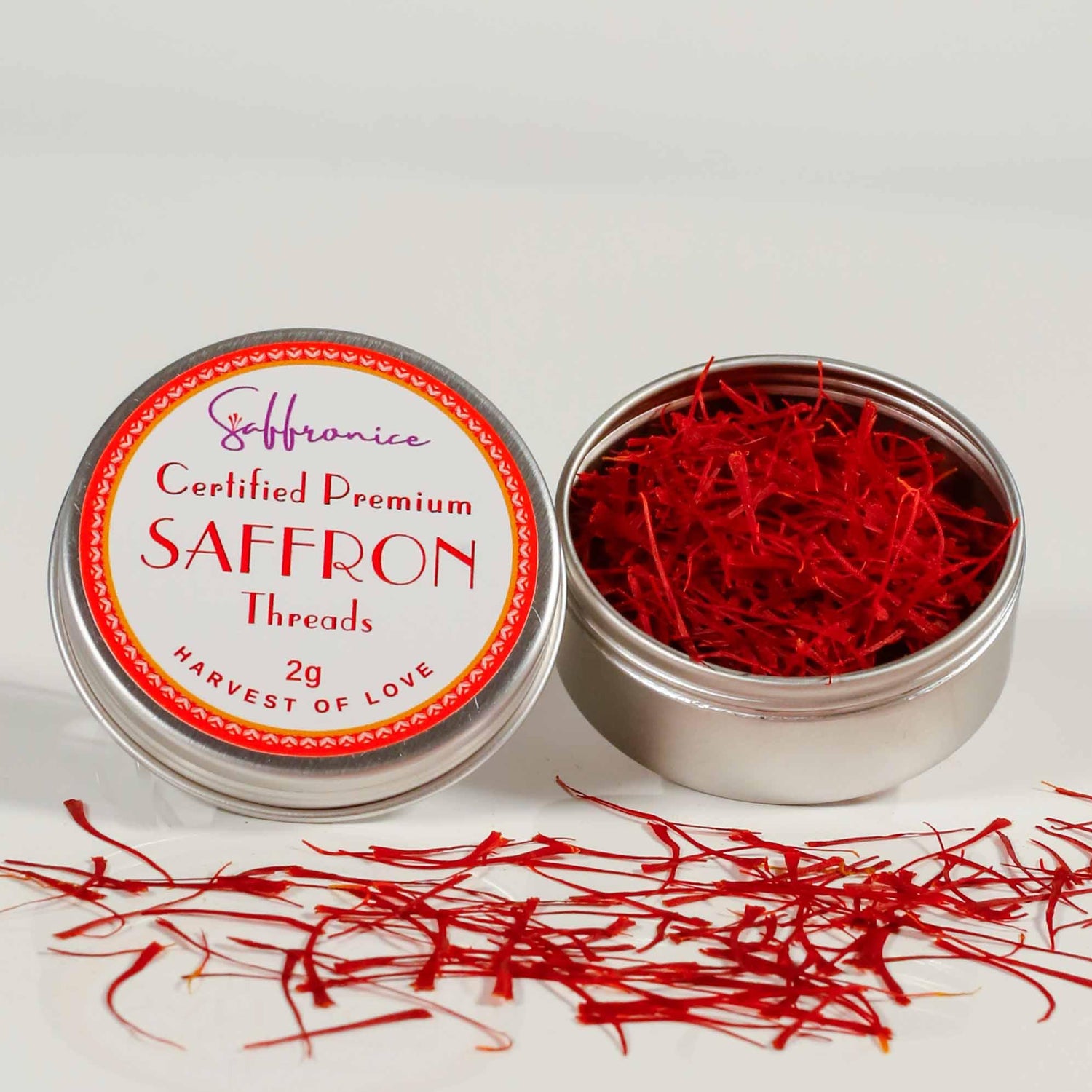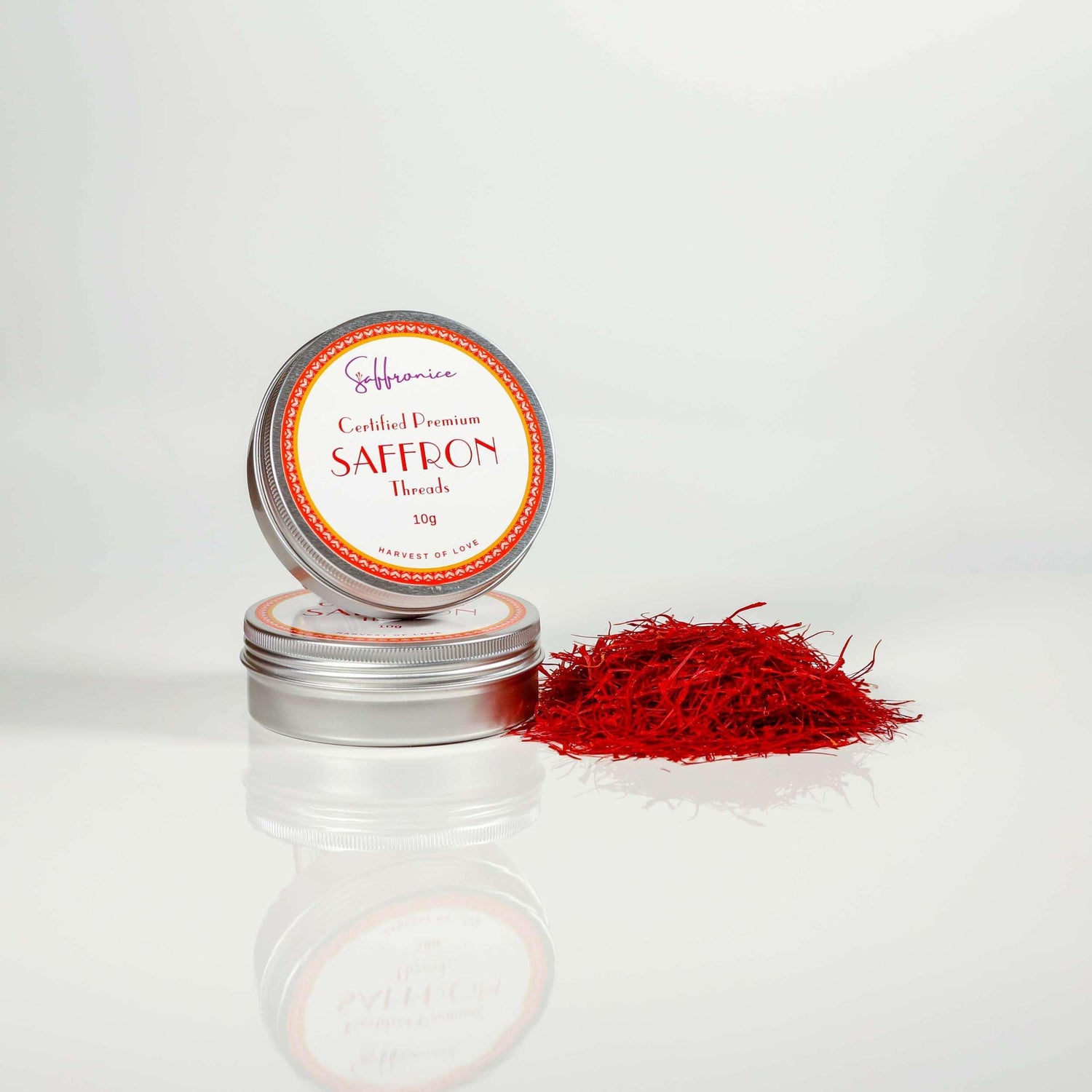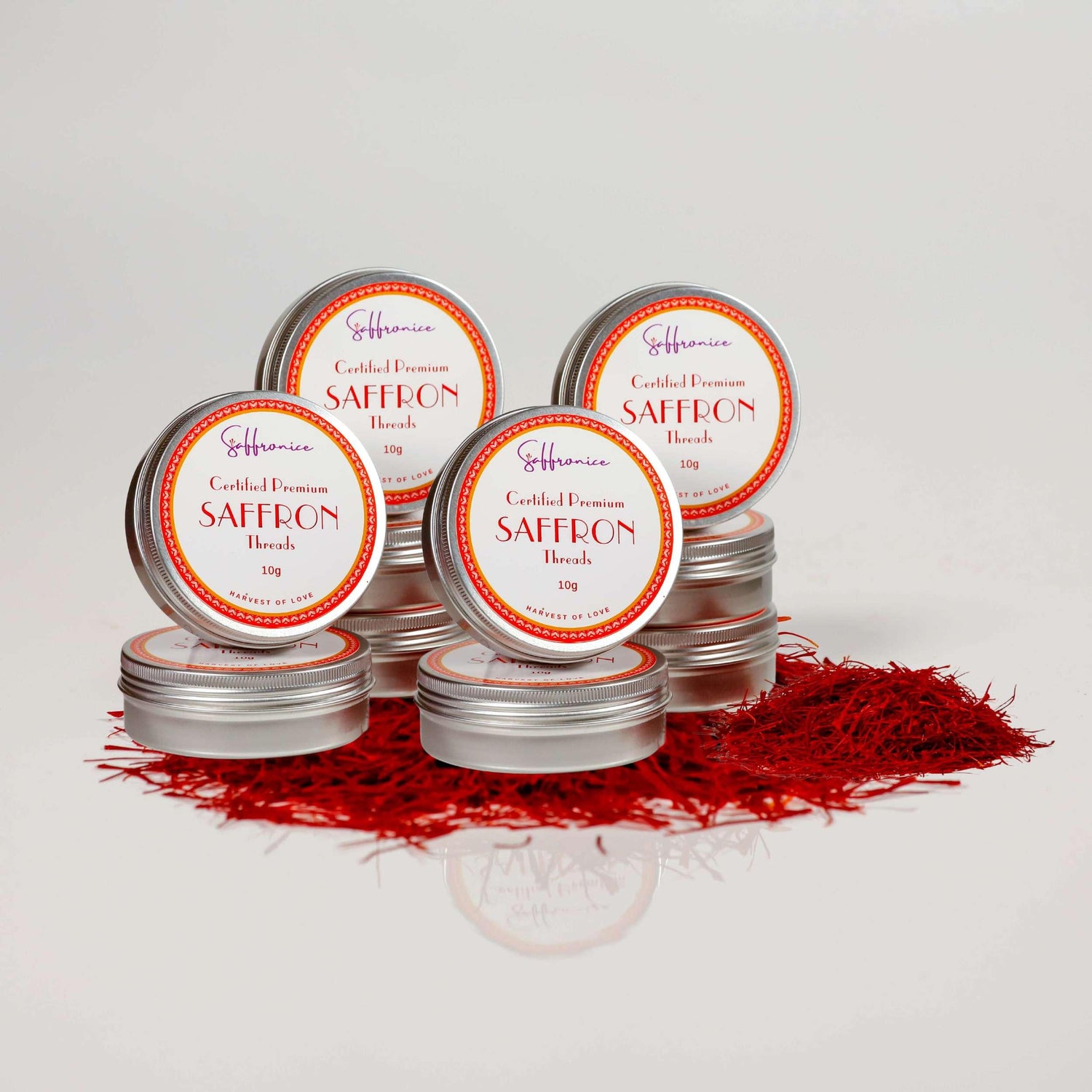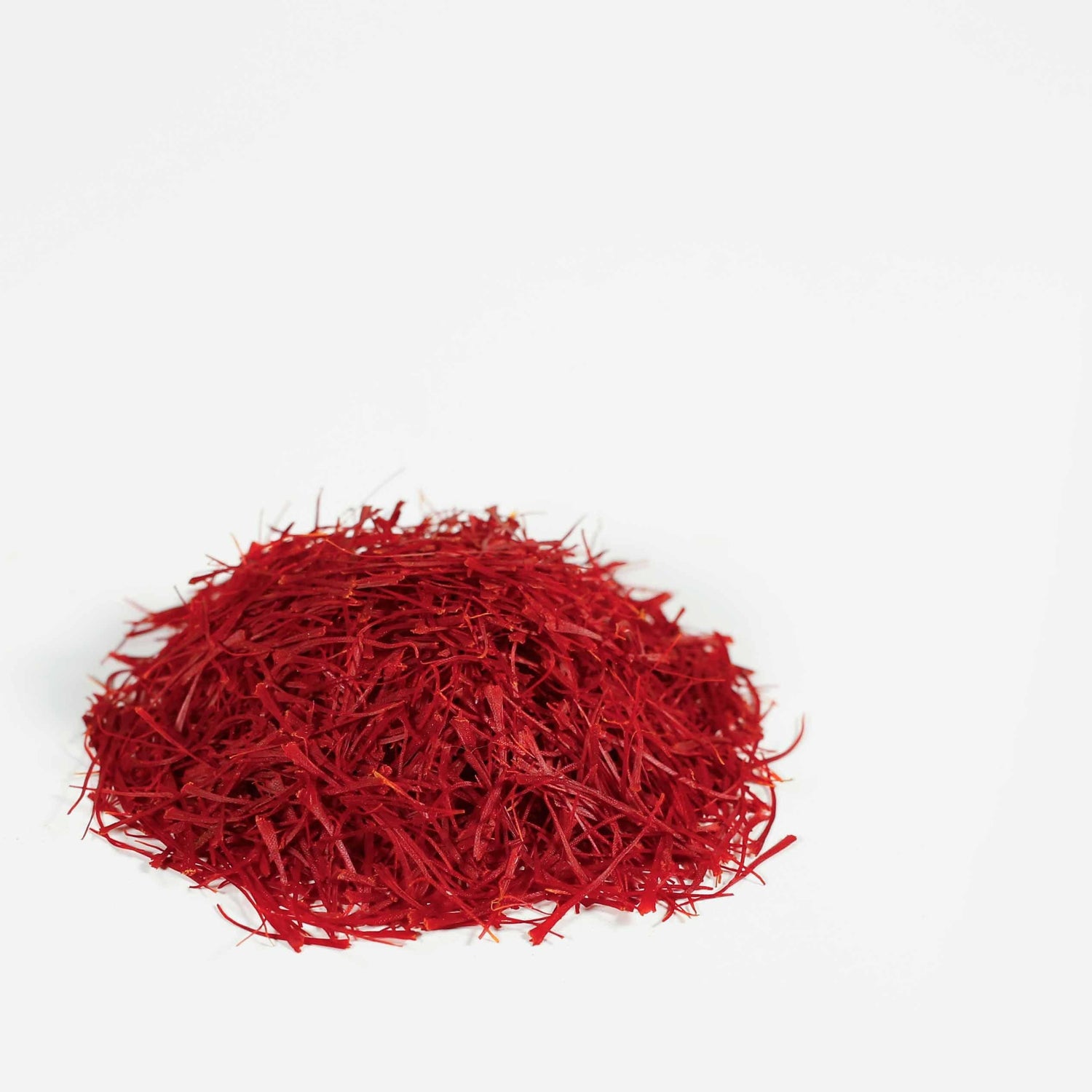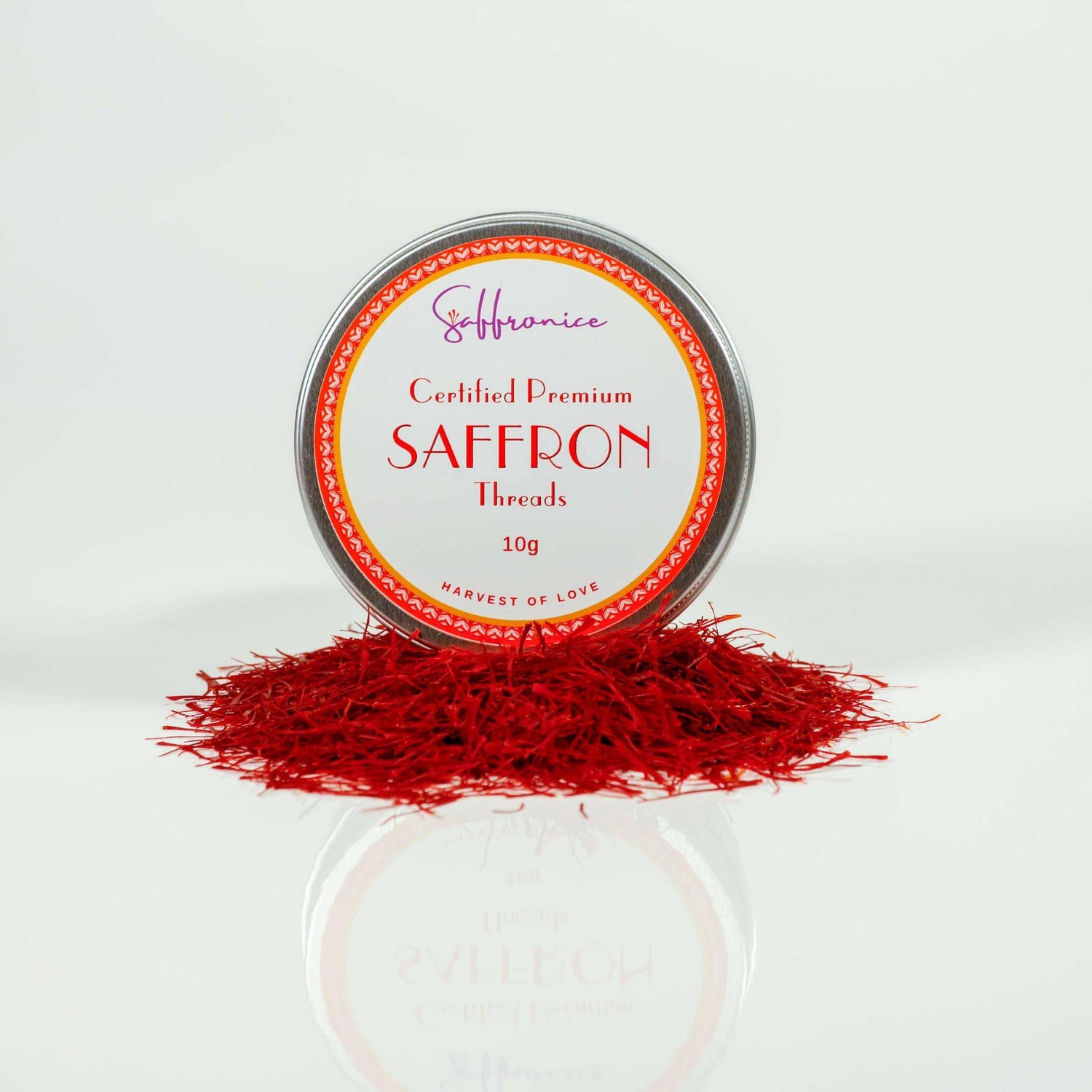Saffron, derived from the Crocus sativus flower, is a prized spice known for its vibrant color, distinctive aroma, and numerous benefits in culinary and medicinal uses (McGimpsey et al., 2003). Harvesting saffron involves meticulous techniques to ensure the collection of high-quality threads (Melnyk et al., 2010).
Adopting best practices in saffron cultivation is crucial for a successful harvest experience. Proper methods not only enhance yield but also preserve the spice’s delicate flavor and potency (Sadeghi et al., 2020).
In this article, we explore various saffron harvesting techniques, including:
- Traditional hand-harvesting methods
- Modern machinery use
- Unique practices in regions like Iran, Spain, and India
By understanding these approaches, you can learn how to harvest saffron in your backyard or on a larger scale effectively.

Understanding Saffron Cultivation
Saffron flourishes best under specific growing conditions (Kafi et al., 2006). Here are key aspects to consider:
Ideal Soil Conditions for Crocus Sativus Growth
- Soil Types: Well-drained, loamy soil is ideal. This type of soil prevents waterlogging, which can cause corms to rot (Negbi, 1999).
- pH Levels: A slightly acidic to neutral pH (6–7) is optimal for saffron growth (Molina et al., 2005).
- Sunlight: Full sun exposure is crucial for the health and productivity of saffron plants (Kafi et al., 2006).
Importance of Organic Matter for Fertility in Saffron Cultivation
- Organic Matter: Enriching the soil with organic matter enhances its fertility, providing essential nutrients that promote healthy growth (Gresta et al., 2008).
- Compost and Manure: Incorporating well-decomposed compost or aged manure increases the organic content, improving soil structure and moisture retention (Ahmadi & Javanbakht, 2012).
Recommended Planting Techniques to Ensure Optimal Growth of Saffron Bulbs
- Planting Depth: Saffron corms should be planted at a depth of 10 to 15 cm. This protects them from frost and ensures they receive adequate nutrients (Molina et al., 2005).
- Spacing: Space corms about 10 cm apart to prevent overcrowding and allow sufficient room for growth (Kafi et al., 2006).
- Larger Corms: Using larger corms (20–30 mm in diameter) can result in multiple blooms per corm, maximizing yield (Gresta et al., 2008).
Proper care in these areas sets the foundation for a successful saffron harvest. Understanding these nuances can significantly impact the quality and quantity of your saffron yield.

The Harvesting Process
Timing is crucial in the saffron harvest. The optimal period to harvest saffron flowers aligns with their flowering stage, which typically occurs in the fall (October to November) (Negbi, 1999). To ensure the highest quality and potency of saffron threads, it is essential to pick the flowers early in the morning after the dew has dried but before they fully bloom (Gresta et al., 2009).
Recognizing When Flowers Are Ready
Several signs help determine when saffron flowers are ready for harvesting:
- Color Change: The petals begin to show a vibrant purple hue (Kafi et al., 2006).
- Flower Opening: Slight opening of the flower indicates readiness, but full bloom should be avoided to prevent exposure to sunlight, which can deteriorate quality (Molina et al., 2005).
- Morning Dew: Harvesting ideally takes place after the dew has evaporated, ensuring that moisture does not affect the stigmas (Gresta et al., 2009).
By paying close attention to these indicators, you can time your saffron harvest accurately and maintain the integrity and flavor of your crop. This precision ensures that each stigma retains its potent aroma and deep color, key characteristics of premium-grade saffron.
Hand-Harvesting Techniques for Saffron Stigmas
Hand-harvesting saffron stigmas is a meticulous process that requires precision and care (Negbi, 1999). Here's a step-by-step guide on how saffron is harvested by hand:
- Identify the Right Time: Harvesting should be done in the early morning after the dew has dried but before the flowers fully bloom. This timing ensures that the stigmas are at their peak quality (Gresta et al., 2009).
- Prepare Your Hands: Ensure your hands are clean to prevent any contamination from scents or residues. Clean hands are crucial for maintaining the purity and flavor of the saffron (Kafi et al., 2006).
- Select the Flower: Gently pick each flower by its base to avoid damaging the delicate petals (Melnyk et al., 2010).
- Extracting the Stigmas:
- Carefully open the flower to expose the three red stigmas inside (Negbi, 1999).
- Using your fingers or a pair of tweezers, gently pluck each stigma without pulling too hard, which could damage both the stigma and the flower (Gresta et al., 2009).
- Place on a Clean Surface: Place the harvested stigmas on a clean, dry paper towel or cloth (Melnyk et al., 2010).
Emphasizing clean hands during this delicate process helps maintain quality. Avoiding any damage to the flowers and stigmas is essential for preserving their integrity and ensuring a high-quality harvest.
Key Techniques:
- Handle each flower and stigma with extreme care to avoid bruising (Negbi, 1999).
- Use gentle motions when plucking stigmas, ensuring they remain intact (Kafi et al., 2006).
By following these steps, you can master saffron harvesting techniques and ensure your saffron retains its vibrant color, aroma, and flavor.
Post-Harvest Handling and Storage Methods for Saffron

Effective Drying Techniques
Proper drying is essential to preserve the flavor and quality of harvested saffron stigmas. Here are some effective saffron drying methods:
- Air Drying: Spread the stigmas in a thin layer on a paper towel or fine mesh screen. Place them in a warm, dark, and well-ventilated area for several days.
- Oven Drying: Set your oven to its lowest temperature. Spread the stigmas on a baking sheet lined with parchment paper. Keep the oven door slightly ajar to allow moisture to escape, checking every 10 minutes until fully dried.
- Dehydrator: Use a food dehydrator set at around 35°C (95°F). Arrange the stigmas on the trays and dehydrate until completely dry.
Tip: Avoid direct sunlight during drying as it can degrade the saffron's vibrant color and potent aroma.
Best Practices for Storing Dried Saffron
Once dried, storing saffron properly ensures its potency and extends shelf life:
- Airtight Containers: Store dried saffron in an airtight container, preferably made of glass or metal (Melnyk et al., 2010).
- Darkness: Keep the container in a cool, dark place away from light exposure, which can diminish saffron's quality (Gresta et al., 2008).
- Humidity Control: Ensure storage conditions are low in humidity to prevent mold growth and maintain dryness (Molina et al., 2005).
- Small Batches: Divide your saffron into smaller quantities if possible. This limits exposure to air each time you use it (Negbi, 1999).
Reminder: Label your containers with the date of harvest to keep track of freshness (Melnyk et al., 2010).
By following these post-harvest handling tips, you can maintain high-quality saffron that retains its exquisite flavor and aroma for an extended period.
Best Practices for Efficient Saffron Harvesting Like a Pro
Managing labor costs in saffron harvesting is crucial, given the intensive nature of the task (Kafi et al., 2006). Efficient practices enable you to balance quality and expenses effectively. Here are some strategies:
1. Labor Requirements
Harvesting saffron requires significant manual labor due to the delicate nature of the process (Negbi, 1999).
- On average, one person can harvest around 150 flowers per hour (Gresta et al., 2008).
2. Cost Management Strategies
- Seasonal Labor: Hire seasonal workers during peak harvesting periods to ensure you have enough hands on deck without incurring year-round costs (Kafi et al., 2006).
- Training Programs: Implement training sessions to increase efficiency and reduce mistakes that could damage the saffron stigmas (Gresta et al., 2009).
- Task Allocation: Divide tasks among workers to streamline the harvesting process, ensuring that each step from plucking to drying is handled efficiently (Sadeghi et al., 2020).
Understanding these practices helps maintain quality while keeping labor costs manageable.
Exploring Traditional vs. Modern Methods in Saffron Harvesting

Traditional Saffron Harvesting Methods
Traditional saffron harvesting methods have been passed down through generations, often involving meticulous hand-picking of the delicate stigmas (Negbi, 1999). This process includes:
- Harvesting Time: Early morning harvests to capture peak flavor and aroma (Gresta et al., 2009).
- Hand-Picking: Carefully plucking the three red stigmas from each flower (Kafi et al., 2006).
- Manual Handling: Ensuring clean hands to maintain the purity and quality of the saffron (Melnyk et al., 2010).
Traditional methods offer unparalleled control over the quality and integrity of the saffron threads. The personal touch ensures minimal damage to the flowers and stigmas, preserving the rich flavor and vibrant color that high-quality saffron is known for.
Saffron Harvesting Machinery
Modern machinery in commercial-scale saffron production aims to enhance efficiency and reduce labor costs (Sadeghi et al., 2020). Some key aspects include:
- Mechanized Harvesters: Machines designed to harvest large quantities quickly.
- Automation: Automated systems for separating stigmas from flowers, reducing time and effort.
- Consistency: Uniform handling processes that minimize human error.
While machinery significantly boosts production rates, it can sometimes compromise the delicate nature of saffron threads. The mechanical process may lead to slight damage or contamination, impacting the ultimate flavor profile (Gresta et al., 2008).
Benefits and Drawbacks

Saffron Harvesting Around the World: A Global Perspective
Iran: The Largest Producer
Iran is the world's largest producer of saffron, accounting for nearly 90% of the total supply (Karimi et al., 2019). Iranian saffron is known for its dark red threads and strong fragrance. Farmers in Iran use traditional methods to harvest saffron by hand, often involving entire families during the short blooming season to carefully pick the delicate stigmas (Kafi et al., 2006).
Spain: High-Quality Strands
Spain, especially the La Mancha region, is renowned for its top-quality saffron (Molina et al., 2005). Spanish farmers use age-old techniques to ensure that each thread is of exceptional quality. The unique climate and fertile soil in this area contribute to the distinct flavor profile of Spanish saffron, making it a preferred choice for cooking.
India: The Unique Kashmiri Variety
In India, the Kashmir region produces a special variety of saffron that is known for its bright color and strong aroma (Bhat & Gupta, 2015). Kashmiri saffron is highly valued for its medicinal benefits and holds great significance in local culture and traditions. Harvesting in this area requires a lot of manual labor, with careful attention given to maintaining the quality of each stigma.
Cultural Significance
Saffron farming goes beyond just being an agricultural practice in these regions; it also holds cultural and historical importance. Here are some examples:
- Iran: Saffron represents Persian heritage and is an integral part of various rituals (Karimi et al., 2019).
- Spain: Festivals are held to celebrate the saffron harvest, highlighting community participation (Molina et al., 2005).
- India: Saffron plays a significant role in traditional medicine and cuisine, showcasing its longstanding cultural significance (Bhat & Gupta, 2015).
These different customs demonstrate the diverse ways saffron is cultivated worldwide.

By following these best practices for harvesting saffron, you can ensure a successful and rewarding experience. Whether you're hand-harvesting or using modern machinery, these saffron harvesting techniques based on the knowledge of saffron growers around the world can help you improve quality and quantity. Explore the world of saffron with confidence and reap the benefits of your hard work. Happy harvesting!
FAQs (Frequently Asked Questions)
What are the key techniques for harvesting saffron?
Saffron harvesting techniques include traditional hand-harvesting methods, modern machinery use, and unique practices found in different regions such as Iran, Spain, and India (Negbi, 1999). Each method has its own significance and impact on the quality of the saffron.
How long does it take to harvest saffron?
The saffron harvesting process typically takes place during the flowering period of Crocus sativus, which usually lasts a few weeks in the fall (October to November) (Gresta et al., 2009). The optimal timing for harvesting is crucial to ensure the best quality of saffron.
What are the best practices for saffron cultivation?
Best practices for saffron cultivation include maintaining ideal soil conditions, ensuring the presence of organic matter for fertility, and employing recommended planting techniques (Kafi et al., 2006). These practices contribute to a successful harvest experience.
How should harvested saffron be handled and stored?
Effective drying techniques are essential to preserve the flavor and quality of harvested saffron stigmas. Once dried, it is important to follow best practices for storing dried saffron to maintain its potency over time (Melnyk et al., 2010).
What are the differences between traditional and modern methods of saffron harvesting?
Traditional saffron harvesting methods involve hand-picking flowers passed down through generations, while modern methods utilize machinery for commercial-scale production (Negbi, 1999; Sadeghi et al., 2020). Each approach has benefits and drawbacks regarding efficiency, cost-effectiveness, and impact on flavor profile.
How does saffron harvesting differ in various countries?
Saffron cultivation practices vary across regions; Iran is one of the largest producers, Spain is known for its high-quality strands, and India is famous for its unique Kashmiri variety (Karimi et al., 2019; Molina et al., 2005; Bhat & Gupta, 2015). Each region also has cultural significance attached to saffron cultivation with distinct practices.
References
- Ahmadi, A., & Javanbakht, S. (2012). Effects of organic manure on corm characteristics of saffron (Crocus sativus L.). Journal of Agricultural Science and Technology, 14(6), 1621–1628.
- Bhat, T. A., & Gupta, S. (2015). Saffron agriculture in India: An overview. International Journal of Agriculture and Crop Sciences, 8(3), 433–436.
- Gresta, F., Lombardo, G. M., Siracusa, L., & Ruberto, G. (2008). Saffron, an alternative crop for sustainable agricultural systems. A review. Agronomy for Sustainable Development, 28(1), 95–112.
- Gresta, F., Lombardo, G. M., Siracusa, L., & Ruberto, G. (2009). Effect of mother corm dimensions and sowing time on stigma yield, daughter corms and qualitative aspects of saffron (Crocus sativus L.) in a Mediterranean environment. Journal of the Science of Food and Agriculture, 89(3), 442–446.
- Kafi, M., Koocheki, A., Rashed-Mohassel, M. H., & Nassiri, M. (2006). Saffron (Crocus sativus) Production and Processing. Science Publishers.
- Karimi, M., Mohammadi, H., & Roosta, H. R. (2019). Saffron production technology and bio-technique. Journal of Applied Research on Medicinal and Aromatic Plants, 12, 13–21.
- McGimpsey, J. A., Douglas, M. H., & Wallace, A. R. (2003). Evaluation of saffron (Crocus sativus L.) production in New Zealand. New Zealand Journal of Crop and Horticultural Science, 21(2), 159–168.
- Melnyk, J. P., Wang, S., & Marcone, M. F. (2010). Chemical and biological properties of the world’s most expensive spice: Saffron. Food Research International, 43(8), 1981–1989.
- Molina, R. V., Valero, M., Navarro, Y., Guardiola, J. L., & Garcia-Luis, A. (2005). Temperature effects on flower formation in saffron (Crocus sativus L.). Scientia Horticulturae, 103(3), 361–379.
- Negbi, M. (Ed.). (1999). Saffron: Crocus sativus L. CRC Press.
- Sadeghi, M., Kafi, M., & Khazaei, H. R. (2020). Mechanization of saffron production to reduce production costs and increase productivity. Journal of the Saudi Society of Agricultural Sciences, 19(3), 161–169.


